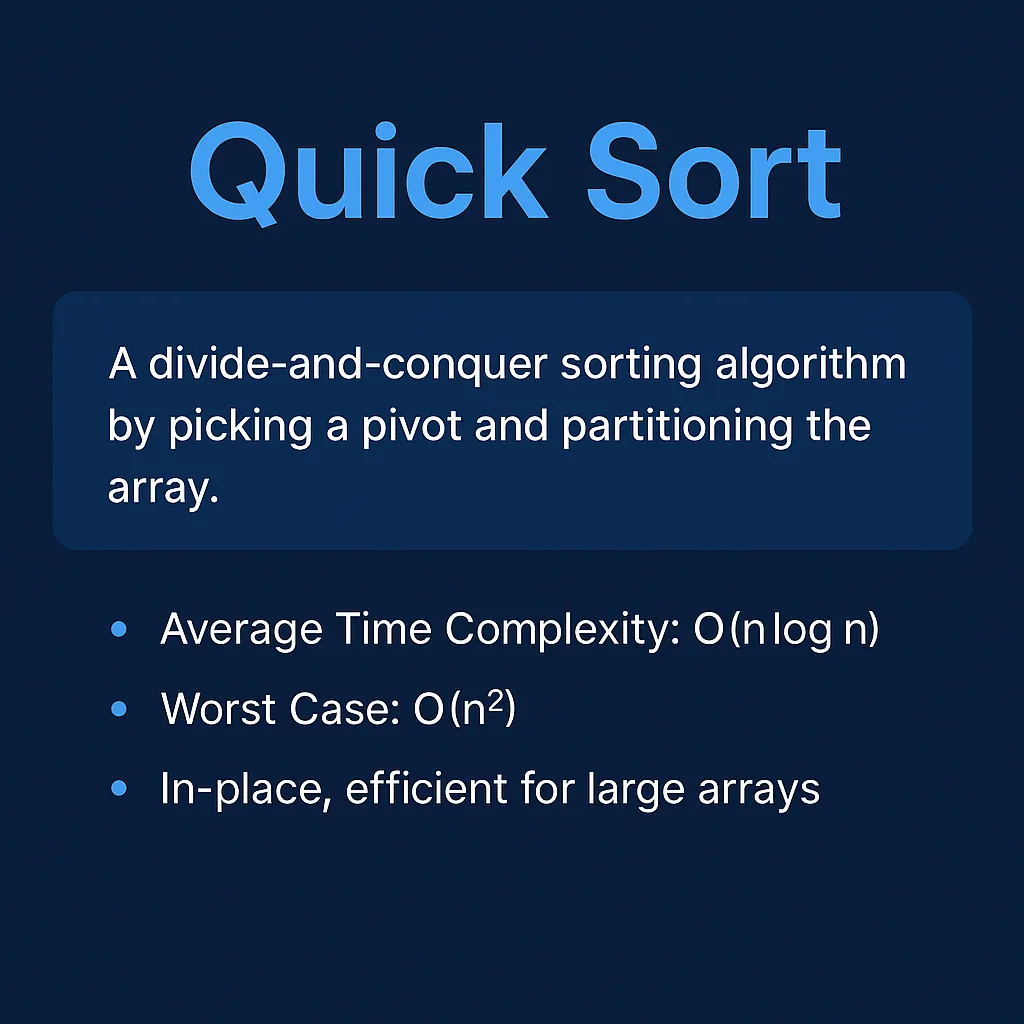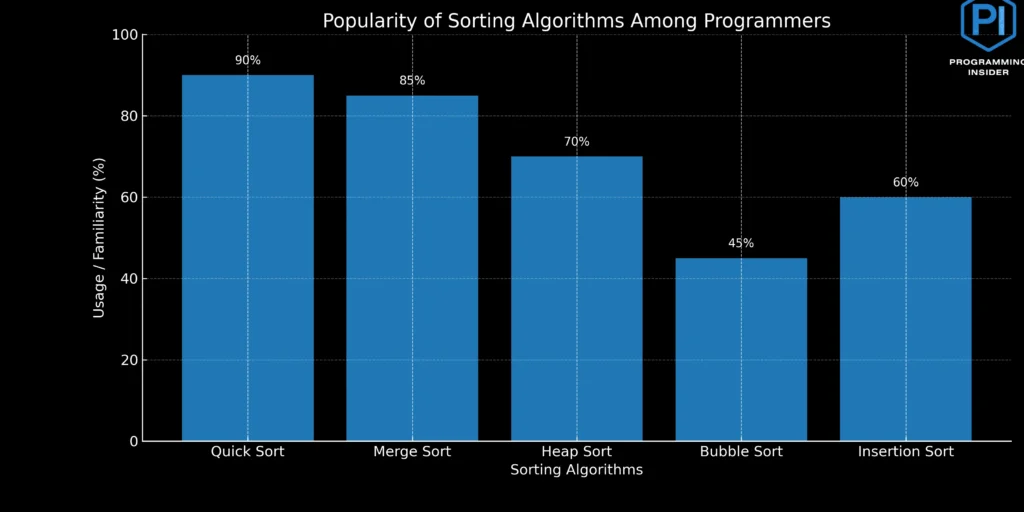While exact percentages vary, most programmers can expect to encounter at least one sorting algorithms related question such as Quick Sort, Merge Sort, or other classic sorts during their technical interviews, particularly for roles emphasizing data structures and algorithms. Sorting plays a critical role in both foundational computer science and real-world applications—from organizing search results to optimizing memory usage. In this guide, we’ll cover the top five sorting algorithms that every programmer should know, and explain when and why to use them.
1. Quick Sort
Quick Sort is one of the fastest and most efficient sorting algorithms for large datasets. It uses a divide-and-conquer strategy by choosing a pivot and partitioning the array into elements less than and greater than the pivot.
Key Features:
- Average Time Complexity: O(n log n)
- Worst Case: O(n²) (if pivot is poorly chosen)
- In-place and efficient for large arrays
When to use: Great for average cases and fast in practice, especially when memory is limited.
2. Merge Sort
Merge Sort also uses the divide-and-conquer approach but guarantees consistent performance even in worst-case scenarios. It splits the array and merges them back in sorted order.
Key Features:
- Time Complexity: O(n log n) for all cases
- Stable sort (maintains order of equal elements)
- Requires extra memory for merging
When to use: Ideal when stability matters, or when you deal with large, linked datasets.

3. Heap Sort
Heap Sort converts the input into a heap data structure and repeatedly extracts the maximum element to sort the array.
Key Features:
- Time Complexity: O(n log n)
- Not stable
- In-place sorting with no extra memory needed
When to use: When you need consistent performance with limited memory usage.
4. Bubble Sort
Bubble Sort is often the first sorting algorithm taught due to its simplicity. It repeatedly swaps adjacent elements if they’re in the wrong order.
Key Features:
- Time Complexity: O(n²)
- Easy to implement, but not efficient
- Stable, but rarely used in practice
When to use: Only for small datasets or educational purposes.
5. Insertion Sort
Insertion Sort builds the final sorted array one item at a time by comparing each new element to those already sorted.
Key Features:
- Time Complexity: O(n²)
- Efficient for small datasets
- Stable and adaptive to nearly sorted arrays
When to use: Great for small or nearly sorted datasets.
Visual Summary
This chart summarizes the relative popularity or familiarity of each sorting algorithm among developers based on practical usage.
Conclusion
Understanding these five algorithms not only strengthens your problem-solving skills but also prepares you for coding interviews and real-world development challenges. Here’s a quick recap:
| Algorithm | Time Complexity | Best Use Case |
|---|---|---|
| Quick Sort | O(n log n) | Large datasets, in-place sorting |
| Merge Sort | O(n log n) | Stability needed, linked structures |
| Heap Sort | O(n log n) | Memory-constrained scenarios |
| Bubble Sort | O(n²) | Teaching/learning purposes |
| Insertion Sort | O(n²) | Small or nearly sorted arrays |

FAQs
Q1: Why are sorting algorithms important in programming?
Sorting algorithms are foundational to computer science and are often used in searching, data organization, and optimization. They’re also a standard part of interviews and system design.
Q2: Which sorting algorithm is the fastest in general use?
Quick Sort is typically the fastest in practice for large datasets, due to its in-place partitioning and average-case time complexity of O(n log n).
Q3: Is Bubble Sort ever used in real-world applications?
Rarely. It’s mainly used in academic settings to teach sorting concepts. Its O(n²) time complexity makes it inefficient for real applications.
Q4: What’s the difference between stable and unstable sorting algorithms?
A stable sort preserves the relative order of equal elements. This can be important in situations where multiple sorting keys are used (e.g., sort by date, then name).
Q5: Which sort should I use when memory is a concern?
Heap Sort and Quick Sort are both in-place and efficient in terms of memory. Merge Sort, though fast, requires extra space.
Q6: How can I visualize how these sorting algorithms work?
Online tools like VisuAlgo, AlgoExpert, or even YouTube animations can help you understand how each algorithm sorts data step-by-step.

